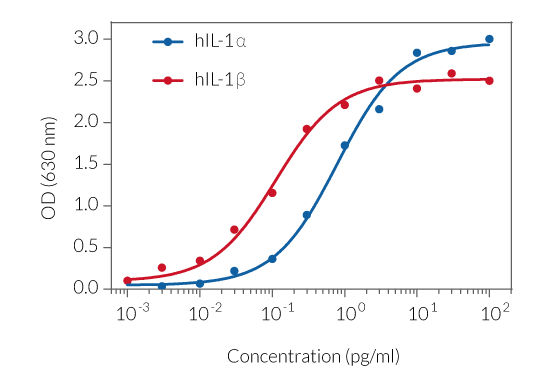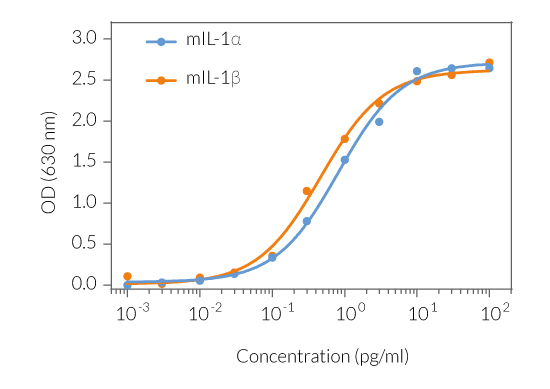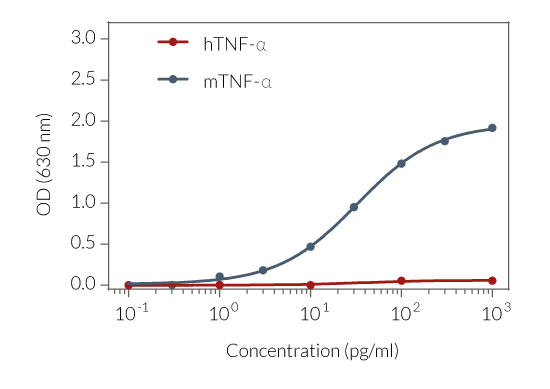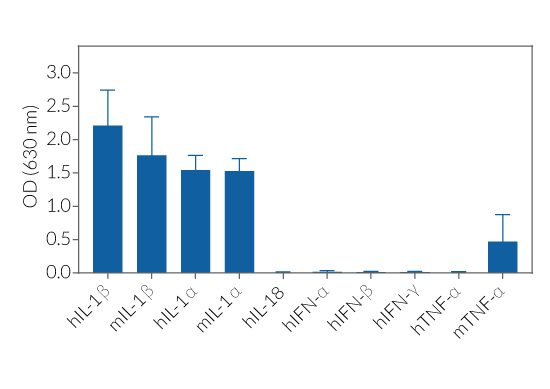IL-1α & IL-1β Reporter HEK 293 Cells
| Product | Unit size | Cat. code | Docs. | Qty. | Price | |
|---|---|---|---|---|---|---|
|
HEK-Blue™ IL-1R Cells HEK 293 reporter cells for human and murine IL-1α & IL-1β cytokines |
Show product |
3-7 x 10e6 cells |
hkb-il1r
|
|||
|
HEK-Blue™ IL-1R vial Additional cell vial |
Show product |
3-7 x 10e6 cells |
hkb-il1r-av
|
Notification: Reference #hkb-il1r-av can only be ordered together with reference #hkb-il1r.
Human & Murine IL-1 Reporter Cells
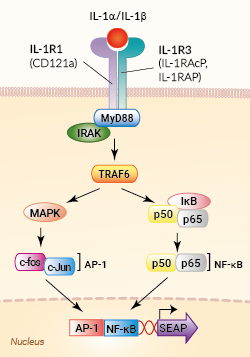
Signaling pathway in HEK-Blue™ IL-1R cells
HEK-Blue™ IL-1R cells were designed to detect bioactive human and murine interleukin-1 cytokines (IL‑1α and IL-1β) in various biological samples (cell culture supernatant and serum) by monitoring the activation of the NF-κB and AP-1 pathways. Additionally, these cells detect bioactive IL-1β from cynomolgus monkeys, dogs, and rats. HEK-Blue™ IL-1R cells can also be used for screening antibodies or small molecule inhibitors targeting the IL-1 pathway.
IL‑1 is a secreted pro‑inflammatory cytokine that plays a critical role in immune responses and inflammation [1].
Cell line description
HEK-Blue™ IL-1R cells endogenously express the human (h) IL-1 receptor and were stably transfected with the murine (m) IL-1 receptor rendering these cells very sensitive to both h/mIL-1α and h/mIL-1β (see figures). They were further transfected with a NF-κB/AP-1-inducible secreted embryonic alkaline phosphatase (SEAP) reporter. The binding of IL-1α or IL-1β to its receptor triggers a signaling cascade leading to NF-κB/AP-1 activation and the subsequent production of SEAP. This can be readily assessed in the supernatant using QUANTI-Blue™ Solution, a SEAP detection reagent.
Of note, the hTNF-α response in HEK-Blue™ IL-1R cells is blocked, while the response to mTNF-α remains intact (see figures).
Key features
- Fully functional IL-1 signaling pathway
- Readily assessable NF-κB/AP-1-SEAP reporter activity
- Strong response to human (h) and murine (m) IL-1α and IL-1β
- No response to hTNF-α, and poor response to mTNF-α
Applications
- Detection and quantification of human and murine IL-1α and IL-1β activity
- Screening of anti-IL-1α or -IL-1β antibodies and anti-IL-1 receptor antibodies
- Screening of small molecule inhibitors of the IL-1 pathway
HEK-Blue™ IL-1β and HEK-Blue™ IL-1R cells
- HEK-Blue™ IL-1β cells are more sensitive to human IL-1 isoforms than murine isoforms. We recommend using this cell line to test supernatant from human inflammasome cellular assays.
- HEK-Blue™ IL-1R cells are stably transfected to additionally express the murine IL-1R, conferring a higher sensitivity to mIL-1α and mIL-1β, when compared to HEK-Blue™ IL-1β cells.
![]() Download our Practical guide on Inflammasomes
Download our Practical guide on Inflammasomes
Reference:
1. Dinarello C., 2018. Overview of the IL-1 family in innate inflammation and acquired immunity. Immunol Rev. 281(1): 8–27.
Back to the topSpecifications
Antibiotic resistance: Blasticidin, Hygromycin B, and Zeocin®
Growth Medium: DMEM, 4.5 g/l glucose, 2 mM L-glutamine, 10% (v/v) heat-inactivated fetal bovine serum, 100 U/ml penicillin, 100 µg/ml streptomycin, 100 µg/ml Normocin™
Guaranteed mycoplasma-free
Detection range for human IL-1β: 0.1 pg - 100 pg/ml
Detection range for human IL-1α, murine IL-1α, and murine IL-1β: 1 pg - 100 pg/ml
Contents
- 1 vial containing 3-5 x 106 cells
- 2 x 1 ml of HEK-Blue Selection (250X)
- 1 ml of Normocin™ (50 mg/ml)
- 1 ml of QB reagent and 1 ml of QB buffer (sufficient to prepare 100 ml of QUANTI-Blue™ Solution, a SEAP detection reagent)
![]() Shipped on dry ice (Europe, USA, Canada and some areas in Asia)
Shipped on dry ice (Europe, USA, Canada and some areas in Asia)
Details
IL‑1 is a secreted pro‑inflammatory cytokine that plays a critical role in immune responses and inflammation [1]. It exists in two distinct isoforms, IL-1α and IL-1β, which are produced as pro-proteins by activated macrophages. IL-1β is cleaved by caspase-1 [2] while IL-1α is cleaved by calcium‑activated calpain or caspase-5 (or its murine ortholog caspase-11) [3]. In contrast to pro‑IL‑1β, pro-IL-1α is active, although cleavage dramatically enhances its bioactivity. IL-1β and IL-1α bind to the same receptor, IL-1R1, triggering the formation of the IL-1R1/IL-1R3/MyD88 complex. This induces signaling leading to the activation of the transcription factors NK-κB and AP-1 with the subsequent inflammatory response [4].
1. Dinarello C., 2018. Overview of the IL-1 family in innate inflammation and acquired immunity. Immunol Rev. 281(1): 8–27.
2. Lopez-Castejon G. & Brough D., 2011. Understanding the mechanism of IL-1β secretion. Cytokine Growth Factor Rev. 22(4):189-95.
3. Wiggins K.A. et al., 2019. IL-1α cleavage by inflammatory caspases of the noncanonical inflammasome controls the senescence-associated secretory phenotype. Aging Cell. 18(3):e12946.
4. Weber A. et al., 2019. Interleukin-1 (IL-1) pathway. Sci Signal. 3(105):cm1.






